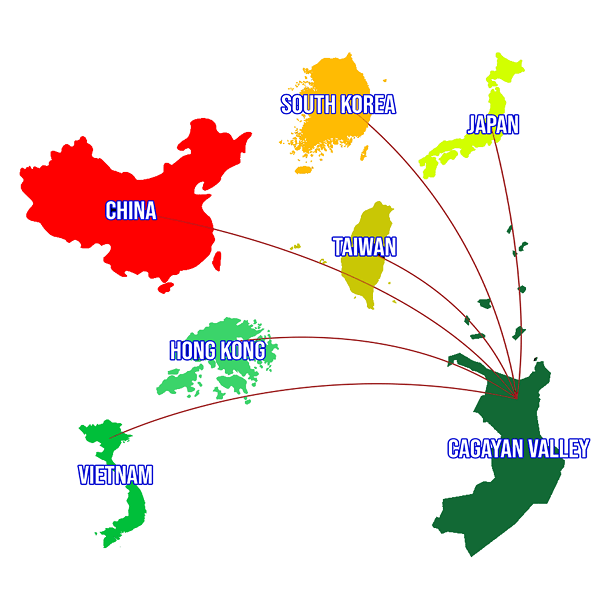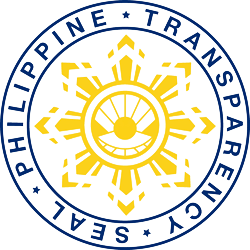PROFILE OF REGION 2

Region 2 or the Cagayan Valley is strategically located on the northeastern part of mainland Luzon. With a total land area of 26,388 square kilometers the Cagayan Valley is the second largest region in the Philippines.
It is bounded to the west by the Cordillera mountain range, to the east by the Sierra Madre, to the south by the Caraballo Mountains, and to the north by the Luzon Strait. The mountains in the east serve as natural barriers from devastating winds during typhoon season.
It is a natural catch basin having the largest watersheds in the country. It is crisscrossed by the longest and largest river network, the Cagayan River, also known as Rio Grande de Cagayan, with a total length of approximately 505 kilometers and a drainage basin covering 27,753 square kilometers.
The valley floor experiences cold winds from November to February, funneled through the opening in the north, and traps surface temperature usually from March to June. With most of the production and settlement areas along the valley floor, frequent exposure to extreme temperature is normal.
The region is largely an agricultural economy with thirty-seven percent (37%) of its total land area dedicated to agriculture production.
Bountifully endowed with vast natural resources and development potentials, from its rich soil, extensive coastlines, renowned rivers and lakes, and widespread forest, grasslands and mountain ranges, and teeming with highly skilled and competent workforce, the Cagayan Valley is becoming a desired investment destination in northern Philippines.
Its proximity to the East Asian countries is a given endowment that makes it not only a natural gateway for trade and investments but also a virtual link to other growth corridors.
Land Area/Population
Cagayan Valley has a total population of 3,685,744, distributed as follows:
Batanes – 18,831
Cagayan – 1,268,603
Isabela – 1, 697,050
Nueva Vizcaya – 497,432
Quirino – 203,823
(PSA, Census 2020)
Number of Provinces/Cities and Municipalities/Barangays/Congressional Districts
Region 2 is composed of 5 provinces, namely, the valley provinces of Cagayan and Isabela, the mountain provinces of Quirino and Nueva Vizcaya, and the island province of Batanes. It has one independent city, three component cities, 89 municipalities and 2,311 barangays within its 12 congressional districts.
Price of land area per square meter in the ecozones and designated investment locations | CEZA – P2,500/sq.m |
Daily Minimum Wage Rates | |
Administrative Position | Retail/Service Establishments employing more than 10 – P370 Agriculture – P345 (Source: National Wages and Productivity Commission data for Region 02) |
Technical Position | |
Managerial Position | |
Setting up housing for foreign nationals | No data available |
Electric Power Rates (per kilowatt hour) | |
Commercial | 7.7 – 10.049 |
Industrial | 7.7 – 10.01 |
Water Supply Rates (per cubic meter) | |
Commercial | 27.42 – 55.29 |
Industrial | 28.33 – 30.77 |
Telecommunication Rates | NDD Calls – P5.10/minute Cellular Calls – P14.00/minute (Source: PLDT/Smart rate) |
Internet Service Rates | P22.00/GB |
No. of Senior High School Graduates/year | Total Senior Highschool Graduates 2017-2018: 27,092 |
Graduates under Academic Track | 16,893 |
Graduates under Technical-Vocational and Livelihood Track | 10,005 |
Graduates under Sports Track | 128 |
Graduates under Arts and Design Track | 66 |
No. of College Graduates/year | 25,561 as of Academic Year 2017-2018 |
Skills and Expertise | Globally competitive tertiary private schools, state universities and colleges and technical vocational schools are continuously producing topnotch graduates in the fields of Engineering, Nursing, Accountancy, Education, Pharmacy and other specializations. There are 23 public HEIs and 49 private HEIs in the entire region producing an average of 23,720 graduates annually. With a high functional literacy rate of 97.2%, the workforces in Cagayan Valley Region are generally easy to train, are English proficient, equipped with competent technical skills, are naturally caring and service oriented, adaptable to any situation, dependable and highly motivated, which are ideal qualities for professional careers and job opportunities across industries here and abroad. |
Available Workforce | As of January 2020, there are 2,443,000 available workforce |
Employment Profile
o Average Labor force participation rate (LFPR) o Average employment rate o Average unemployment rate o Average underemployment rate
| Employment rate in Region 2 has always been among the highest across regions. In January 2020, the employment rate in Cagayan Valley remained high at 96%, which was way above the national average 94.7%. while the unemployment rate was recorded at 4% and underemployment at 16.3%. But due to the Covid-19 pandemic, the employment rate dropped by 12% at 84.4% for the month of April. The Region recorded a 77% increase in the unemployment rate from 4% to 17.7%, and a slight increase of 4.1% in underemployment. The number of people available for work (Average labor force participation rate (LFPR)) is 64.4% in January 2020 and 55.6% in April 2020. |
Year-to-Date Growth Rate exports statistics | TBD |
2019 Export Growth Rate | TBD |
2018 Export Growth Rate | TBD |
Regional share to total PH exports | TBD |
Regional share to total PH exports growth rate | TBD |
Provincial shares to total PH exports | TBD |
Top Regional Exported Products | TBD |
List of Regional Products for Promotion | Being an agriculture economy, the Cagayan Valley Region is not only known for its huge production in corn and rice. It is slowly being recognized as among the top producers of the following high value crops: 1. Mango 2. Citrus ( Mandarin & Calamansi) 3. Pineapple 4. Banana 5. Coffee 6. Cacao 7. Peanut The region also promotes the following products: 8. Handicrafts 9. Shrimps |
List of Top Services for Promotion | Agribusiness remains to be the largest contributor to industrial development in the Region. However, the following services are seen to have great potentials hence, are being promoted: 1. Construction and Real Estate Development 2. Agri-Trading 3. ICT-BPM
|
List of Exporting Companies | TBD |
Latest available investments data |
| ||||||||||||
o BOI-PEZA Approved Investments o Share to PH (?) total approved investments o FISCAL INCENTIVES. In addition to the fiscal incentives provided by laws and by the Local o Government Code of 1991, registered enterprise’s project shall enjoy exemptions from business o tax, real property tax on the share of the City and transfer tax, which shall take effect only during o the next calendar year after project completion. o Investment Growth Rate | From 2016 up to May 2020, the Cagayan Valley Region’s total BOI Approved Investments amount to 35,497.82 million pesos which accounts for .87% share to the Philippines total approved investments. (The amount does not include nationwide projects.) | ||||||||||||
Incentives being offered by the region to Registered and Existing Enterprises | Local incentives, both fiscal and non – fiscal, are provided to investors who locate in any area in the region, aside from the incentives that the Board of Investments provide BOI and PEZA-registered companies. Local Fiscal Incentives
In addition to the fiscal incentives provided by National laws, registered enterprise’s project shall enjoy exemptions from business tax, real property tax and transfer tax, which shall take effect only during the next calendar year after project completion. The schedule of incentives is based on the preferred activities and amount of project investments. Example: ● For Infrastructure, creative and knowledge-based industry, alternative energy and waste management projects, the following schedule applies:
● Tourism, agri-business or agro-industries with One Hundred Million (P100,000,000.00) and above project investment shall enjoy 100% business tax exemption for the first five (5) years of operation plus one (1) year Real Property Tax exemption on the share of City including Transfer Tax. ● Tech Industry and Alternative Energy projects with the investment of not lower than Two Billion Pesos shall enjoy 100% business tax exemption for five years plus one (1) year Real Property Tax exemption on the share of the City including Transfer Tax. Non-fiscal incentives a. One stop documentation for simplified registration procedure b. Assistance in resolving issues and concerns with National Government Agencies, NGOs and other service providers; c. Support for industrial peace through reconciliation; d. Assistance in securing electric power and water supply connection; e. Coordination in the negotiation of special rates for utilities for industries with a certain minimum load, if applicable; f. Assistance in site selection and negotiation for right of way, if applicable; g. Networking with concerned National Government Agencies (NGAs) and other similar institutions for trainings of workers to enhance their skills. h. Assistance in identifying and sourcing of skilled human resources; and i. such other aftercare services that may be accorded to investors. The Cagayan Economic Zone Authority (CEZA) likewise provides the following incentives to CEZA locators as follows: CEZA Fiscal and Non-fiscal incentives ● Special tax rate of 5% of gross income in lieu of all local and national taxes ● Tax credits for foreign corporations ● Tax and duty free importation of articles, raw materials, capital goods, equipment and consumer items ● Permanent resident status for foreign investors and immediate family (must maintain not less than US$150, 000 capital) ● Other applicable incentives under Omnibus Investment Code of 1987: ● Multiple entry visa, valid for a period of two years ● Tax treatment of merchandise in the Zone ● Tax credits ● Additional deduction for labor expense ● Exemption from local taxes and licenses ● Exemption from Contractor’s Tax ● Exemption from Wharfage Dues and any Export Tax, Duty, Impost and Fee on non-traditional export products | ||||||||||||
Major Companies in the Region |
| ||||||||||||
o BOI Approved Projects (2016 – 2020) | There are 29 BOI Approved Projects (See attached complete list please click here) including 4 Information and Communication projects located nationwide. Excluding the cost of the 4 projects, the 25 projects cost 35,497.83 million pesos.The largest projects include the following:
| ||||||||||||
o PEZA-registered Company | 1. Green Future Innovations, Inc., Sta. Filomena, San Mariano, Isabela | ||||||||||||
List of Investment Opportunities | Investors who come to the Cagayan Valley Region have varied options for sound business ventures either under Private-Public Partnership (PPP) or joint venture on the following: 1. Industrial tree plantation (bamboo, rubber rattan, soft wood) 2. Agri-trading 3. Real Estate Development and Infrastructure 4. IT-BPM 5. Logistics 6. Warehouses and cold chain facilities 7. Ecozone Development 8. Renewable energy 9. Waste management | ||||||||||||
List of Priority Sectors | 1. Agri-business (Mango,Citrus ( Mandarin & Calamansi), Pineapple,Banana, Coffee, Cacao, Peanut) 2. Construction 3. Tourism 4. IT-BPM and e-Commerce 5. Logistics 6. Industrial tree plantation (bamboo, rubber rattan, soft wood) | ||||||||||||
Activities for Investment Promotion in the Region | Lately, large investments have been pouring into the Cagayan Valley region. This is attributed to the bold steps made and purposive investment promotion initiatives undertaken by the provincial and municipal/city local government units. ● All 5 Provincial Local Government Units (PLGUs) and 82 Municipal and City LGUs have their respective Local Investment and Incentives Code (LIIC) providing Fiscal and Non-Fiscal Incentives. ● LGUs have designated Local Investment and Economic Promotion Officers (LEIPOs) rendering investment servicing interventions to potential and existing investors. Some LGUs have created permanent positions manning their Investment Promotion Units. ● Regional Line Agencies and LGUs embark on focused and purposive investment targeting and marketing initiatives such as Investment Conferences, Inbound and Outbound Investment Mission, Investment Matching among others. |
List of Established Shared Service Facilities (SSFs) Project in the Region | As of December 31, 2019, DTI- Region 2 has already established a total of 278 SSFs across the Region distributed as follows:
| ||||||||||||
Go Negosyo Centers | There are 74 Negosyo Centers spread all over the region to bring the services of DTI closer to the communities:
|





